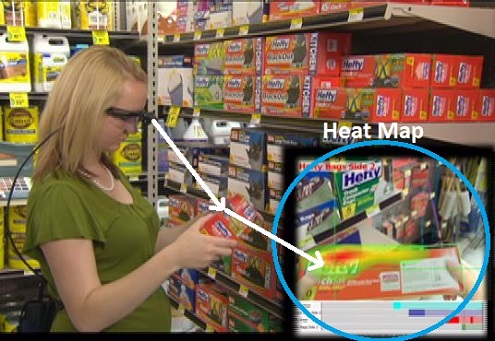Market Research with eye tracking technology
 Marketing professionals rely heavily upon marketing research to garner insights into customer opinions and behavior. Conducting a market research study based solely on asking participants to explain why they did or did not engage with a branding message or environment is unscientific and inaccurate.
Marketing professionals rely heavily upon marketing research to garner insights into customer opinions and behavior. Conducting a market research study based solely on asking participants to explain why they did or did not engage with a branding message or environment is unscientific and inaccurate.
Participants may be able to formulate an answer to their visual behavior; however, visual attention involves conscious and unconscious impulses. Therefore, participants may not really understand their own visual behavior, resulting in participants creating inaccurate explanations for their patterns of visual attention. Eye tracking is incredibly effective at reading these non-verbal reactions to stimuli.
 Researchers are able to glean important insights into viewers' engagement with marketing material through analyzing visual behavior. As a result, researchers are turning to eye tracking more and more to find the real answer as to why consumers behave the way they do.
Researchers are able to glean important insights into viewers' engagement with marketing material through analyzing visual behavior. As a result, researchers are turning to eye tracking more and more to find the real answer as to why consumers behave the way they do.
Eye tracking allows market researchers to take their studies to another level by allowing them to collect concrete data that can be statistically analyzed and graphically rendered. By measuring pupil dilation, fixations, blinks and a variety of other visual behaviors researchers can determine the effectiveness of a given medium or product. Eye tracking gives a more direct access to the viewer's thought processes through visual behavior analysis. When observing participants visual gaze patterns a researcher can understand the viewer's thought processes. What are they looking at and why? Is the viewer paying attention to the branding details that they are intended to be attention grabbing? Is there a link between branding visuals and the ability of the viewer to recall branding information at a later date?
 When combining eye tracking data with contextual information relating to the advertisement, the participant’s demographic data and the participants self-reported data, the researcher is able to determine the viewers' overall engagement with an advertisement. Combining the observed behavior and individual opinions researchers are able to determine what marketing messages are impactful to viewers and which messages are forgettable. Eye tracking allows an organization to determine if the viewer understands its marketing message.
When combining eye tracking data with contextual information relating to the advertisement, the participant’s demographic data and the participants self-reported data, the researcher is able to determine the viewers' overall engagement with an advertisement. Combining the observed behavior and individual opinions researchers are able to determine what marketing messages are impactful to viewers and which messages are forgettable. Eye tracking allows an organization to determine if the viewer understands its marketing message.
There are numerous benefits to running eye tracking studies to test prospective marketing campaigns before they are launched. Eye tracking provides market researchers with the opportunity to examine the visual behavior of a consumer while interacting with a target package. This may be used to analyze distinctiveness, attractiveness and the tendency of the package to be chosen for purchase. The visual behavior analysis could identify problems with a campaign enabling them to be corrected before the campaign begins. This has the potential to make campaigns more effective and allow the marketer to avoid the situation where viewers are watching an advertisement with little idea of what the marketer is trying to sell.
User Experience: Eye tracking and its application in usability and media research (SCHIESSL et. al)
"Eye tracking reveals higher validity in data compared to conventional methods...another well known major validity problem using conventional usability methods arises when testing subjects in an artificial environment, such as a usability lab. Subjects are aware of the test situation. The description and verbalisation of their own behaviour might be biased in terms of social expectations, political correctness or simply to give a good impression.”